


REPORT 2023 - 2024






REPORT 2023 - 2024


As I reflect on the 2023-2024 season at the Kino Bay Center, I am sincerely honored and grateful to be part of this diverse community of people working together effectively toward common goals in biocultural conservation, science, education and social justice. This growing community includes Center staff, community members from Punta Chueca, Desemboque and Bahía de Kino, students, faculty, donors, Prescott College staff and alumni, researchers from far and wide, donors, partner academic and non-profit institutions and others. This interdisciplinary community involves 100s of people actively participating today, and has grown from the contributions of 1000s of people over decades. This human community is based on long-term relationships, effective collaboration and planning, diverse backgrounds, knowledge, skills and connections. What makes this community special is more than just the quality, depth and scope of work being done in science, education, community, communication and conservation; it is the cooperation, trust, heart, co-creation and support that motivates us every day, builds momentum and inspires hope and action.
The activities and results summarized in this report tell a story of growth and maturity of the Center on all levels. As our programs mature, we are better able to apply long-term data and projects to concrete bio-cultural conservation and actions. THANK YOU to everyone who has contributed to the accomplishments of the 2023-2024 season and to the creation of this unique community over the years!
Lorayne Meltzer Executive Director and


Prescott College (PC), a private university in Arizona, began offering classes in the Kino Bay region in the 1970’s. The Center opened in 1991, and in 1992 the Mexican non-profit organization (Prescott College A.C.) was established. Prescott College A.C. and Prescott College U.S. work together to operate the Center as a bi-national organization with the active consultation of the Kino Bay Center Executive Council.

The Kino Bay Center for Cultural and Ecological Studies (the Center) is a bi-national field station dedicated to experiential education and community-based environmental conservation. Our integrated programs are grounded in a constant presence in the region. Each year, we host approximately 1,200 researchers, students, faculty, community members, and visitors from dozens of institutions, and community groups from Mexico, the United States, and other parts of the world.

MISSION: Protect priority species and habitats through the integrated application of science, education, knowledge exchange, and community participation in conservation initiatives.
VISION: Promoting and modeling collaborations between people from different cultures and institutions to co-create solutions to complex conservation challenges.
The biocultural landscape of the Eastern Midriff Island Region of the Gulf of California is unique on a global scale. The great diversity of habitats and environmental conditions is linked to high productivity and species diversity. The region’s many islands are legally well-protected and provide habitat for waterbird colonies, California Sea Lion reproduction, and Sonoran Desert flora and fauna, including many endemic species. The region is home to diverse local and indigenous communities with overlapping social, cultural, and economic relationships with each other and the natural environment. Local leaders, indigenous communities, fishermen, students, faculty, researchers, and resource managers co-exist in the region and have complimentary perspectives for addressing threats and promoting and supporting healthy ecosystems and human communities.




Key Achievements
• Facilitation of truly multi-cultural field-based learning experiences
• Increased participation of PC masters and PhD students
• Increased participation of Center Staff as mentors
• Contributions of valuable conservation, science, and community projects by Prescott College students
Impact
Classes at the Center inspire and train students to make a difference through advanced study and careers in fields related to socially just environmental conservation.
Students explored outdoor skills, language, culture, natural history and human-environmental relationships in 5 Prescott College Classes and 10 mentored studies and senior projects this year. The steadily increasing number of P.C. graduate students at the Center elevates the level of inquiry for everyone. In addition, the Center’s program staff supported 3 professional practicum, thesis and social service students from regional Mexican institutions. Students consistently appreciate the unique opportunities to gain knowledge and skills in field-based, applied and real-world contexts.
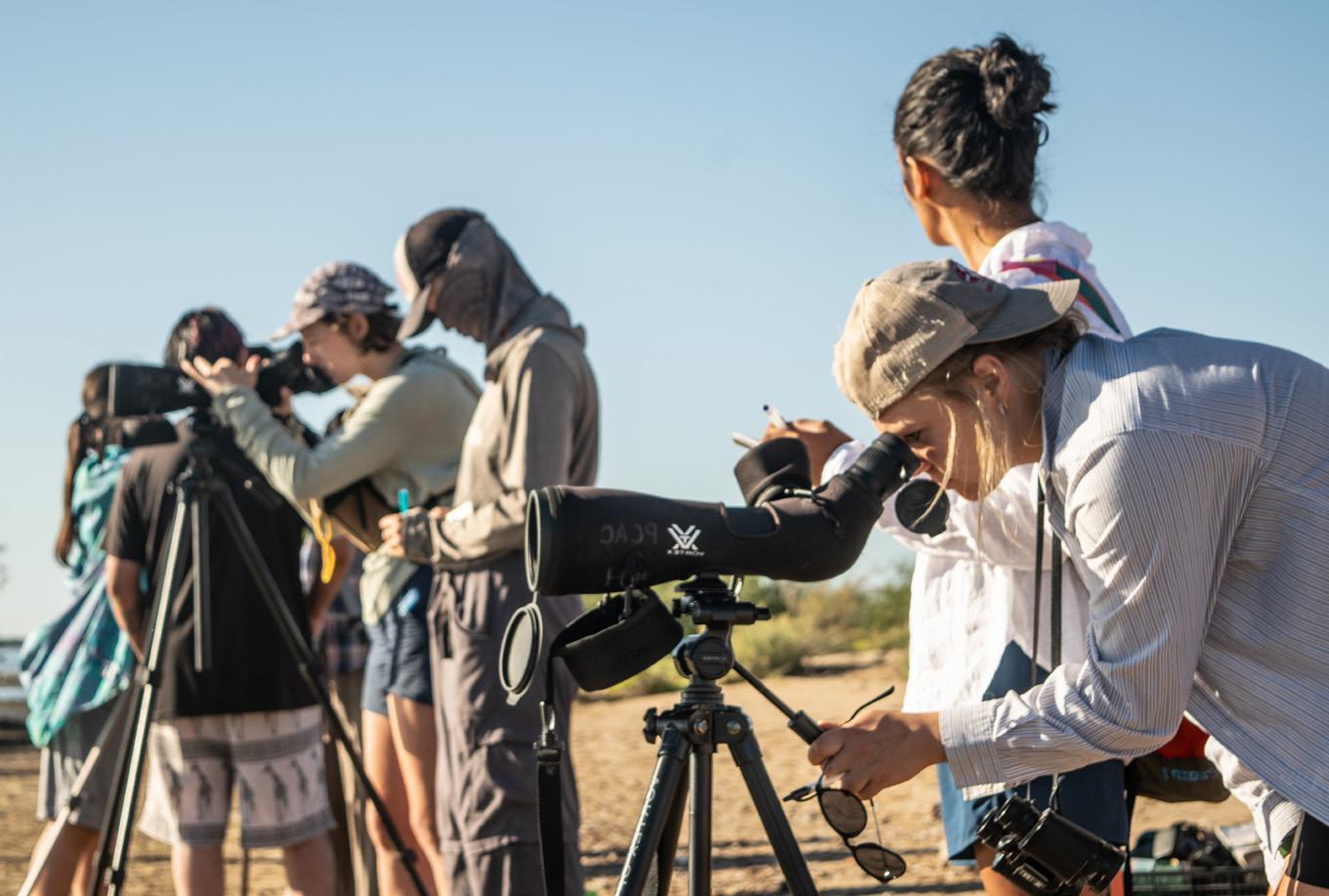
Fall 2023 Semester
• Marine Studies: Natural History of the Gulf of California
• Marine Studies: Cultural Geography
• Marine Studies: Society and Environment
• Mentored Studies/Thesis/Senior Project students
• Professional Practicum/Social Service students
Spring 2024 Semester
• Spanish Intensive and Cultural Immersion
• Sea Kayaking and Marine Natural History
• Mentored Studies/Thesis/Senior Project sudents
• Professional Practicum/Social Service students

• The Natural History of the Gulf of California class felt the interconnection between desert, sea, islands, and wetlands, familiarized themselves with their inhabitants and learned to observe with a critical eye.
• Cultural Geography students had the opportunity to observe and interact with the diverse lineages present in the region; learning traditional skills on Isla Tiburon with Comcaac teachers and trying their hands at traditional cattle ranching; seeing firsthand how history and geography shape identities, politics, economies, and landscapes.
• Society and Environment students spent time on shrimp trawlers, observed large-scale aquaculture practices, participated in community-based conservation projects, and developed a deep understanding of the societal values that shape human/nature relationships.
• Sea Kayaking and Marine Natural History gratefully returned to Kino in January 2024. As apprentices to the sea, students practiced paddling skills in Bahia Kino waters while learning about wind, waves, weather, water birds, marine invertebrates, and marine mammals.
• Spanish Intensive students and host families shared 3.5 weeks of language immersion and expanding world views. Both students and host families expressed the powerful impact of forming deep personal connections with people from very different cultures and backgrounds.

• Facilitation of 2 Prescott College alumni trips, reconnecting former students with the Center and each other
• Instruction of our largest Biocultural Explorations multi-day program, with 24 participants engaged in immersive activities
• Support for the most visiting groups in the Center’s history, achieving a significant milestone in our outreach efforts
Educational experiences at the Center foster a deeper understanding of diverse cultures and ecosystems and encourage critical thinking toward open-minded, inclusive and globally aware mindsets.
Our visiting groups’ program continued to flourish this season, hosting 181 students, faculty, staff, and life-long learners from non-Prescott College institutions. Sixteen groups from across the U.S. visited the Gulf of California for our Biocultural Exploration programs, engaging in marine mammal studies, waterbird observation, turtle monitoring, and traditional ecological knowledge experiences. Participants left with fresh perspectives and a deeper understanding of the region and the Center’s work. We are inspired by the enthusiasm and curiosity of our visitors and excited about this growing component of the Center’s activities.
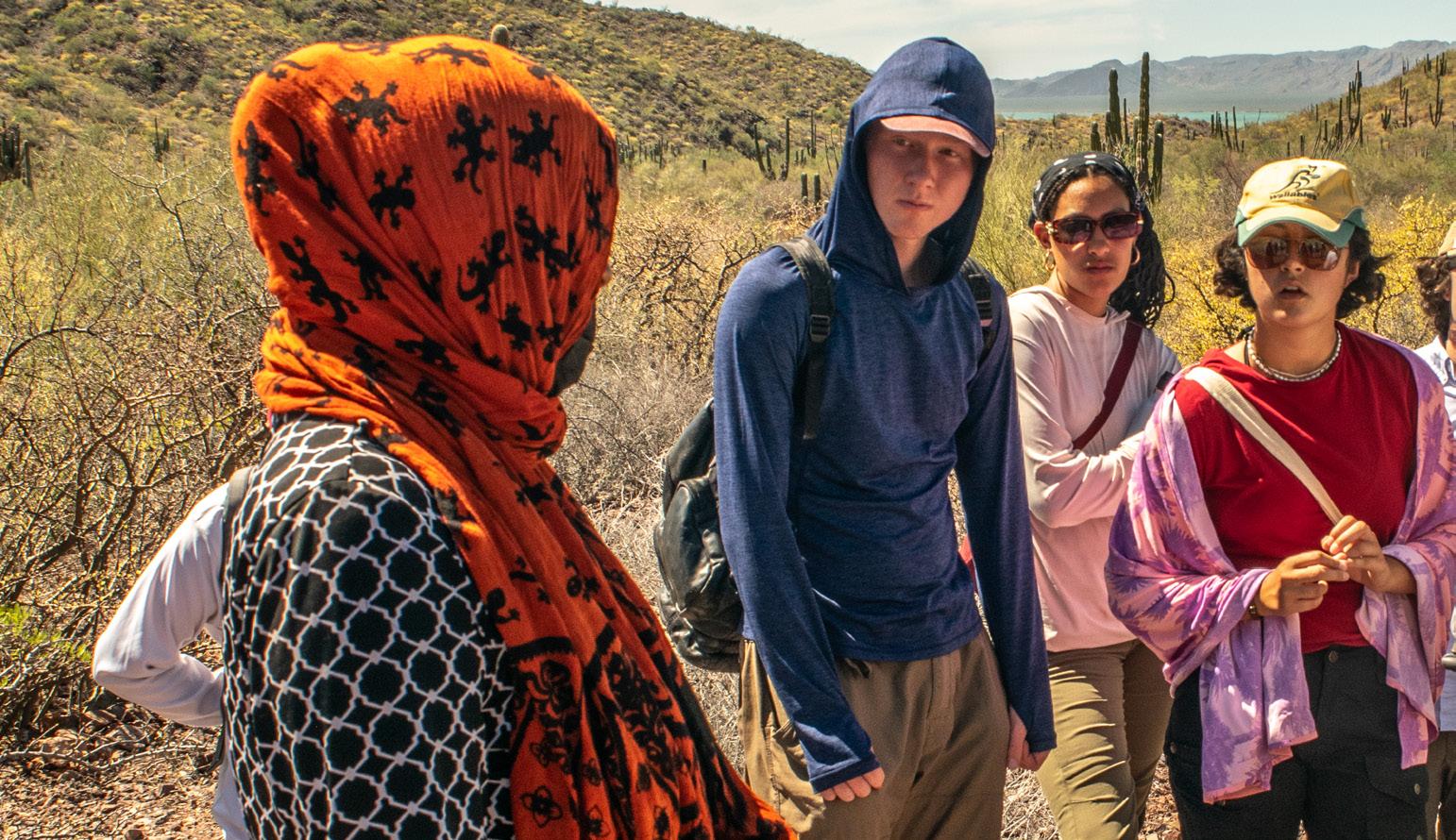
Fall 2023
• TARA Performing Arts High School, Boulder, CO
• Adventures Unplugged Prescott College, Prescott, AZ
• Prescott College Kino Bay Center Alumni trip
• Field Guides Birding Tours, TX


Spring 2024
• Treehouse Learning Community, Prescott, AZ
• Colorado Rocky Mountain School, Carbondale, CO
• Border Community Alliance, Tubac, AZ
• Shining Mountain Waldorf School, Boulder, CO
• Cochise Community College, Douglas, AZ
• Duke University, Beaufort, NC
• Udall Family Kayaking Group, CO
• Watershed School, Boulder, CO
• Northpoint High School, Prescott, AZ
• Prescott College Faculty and Staff trip, Prescott, AZ
• Prescott College Kino Bay Center Alumni trip
• Student Diplomacy Corps, San Diego, CA
Highlights from this year’s visiting groups
• Colorado Rocky Mountain School: Students enjoyed waterbird monitoring in estero La Cruz and camping in estero Santa Rosa, where they learned about the constellations from Comcaac guides.
• Northpoint: Participants were surprised by an encounter with whale sharks during their boat day, witnessing juveniles up close as they fed on krill.
• Shining Mountain Waldorf School: Students snorkeled for clams off the coast of Tiburon island and learned how to prepare them once back on land.
• Cochise Community College: Participants explored the multifaced approach to science by spending time with the Center’s staff on program outings, with the addition of Intertidal zone explorations.
Supporting the efforts of researchers, NGOs and academic institutions doing work in the region enriches the experiences of researchers, community members and staff. We provide local knowledge and logistical support and facilitate connections between visiting researchers, local communities and other partners. We also work with researchers to insure they have the required permissions for their work, and then to return the results of the work to local communities. This year the Center supported 36 researchers conducting 10 projects, addressing a wide variety of topics including; geology, environmental anthropology, medicinal plants, ctenophores, bats, chuckwallas and climate change and cultural history of the Comcaac (to name a few).
Collaborating with Prescott College Marine Mammal Program has been a very rewarding experience due to the openness, ease of dialog and shared multidisciplinary vision of marine mammal conservation.
Ph.D Casandra Gálvez
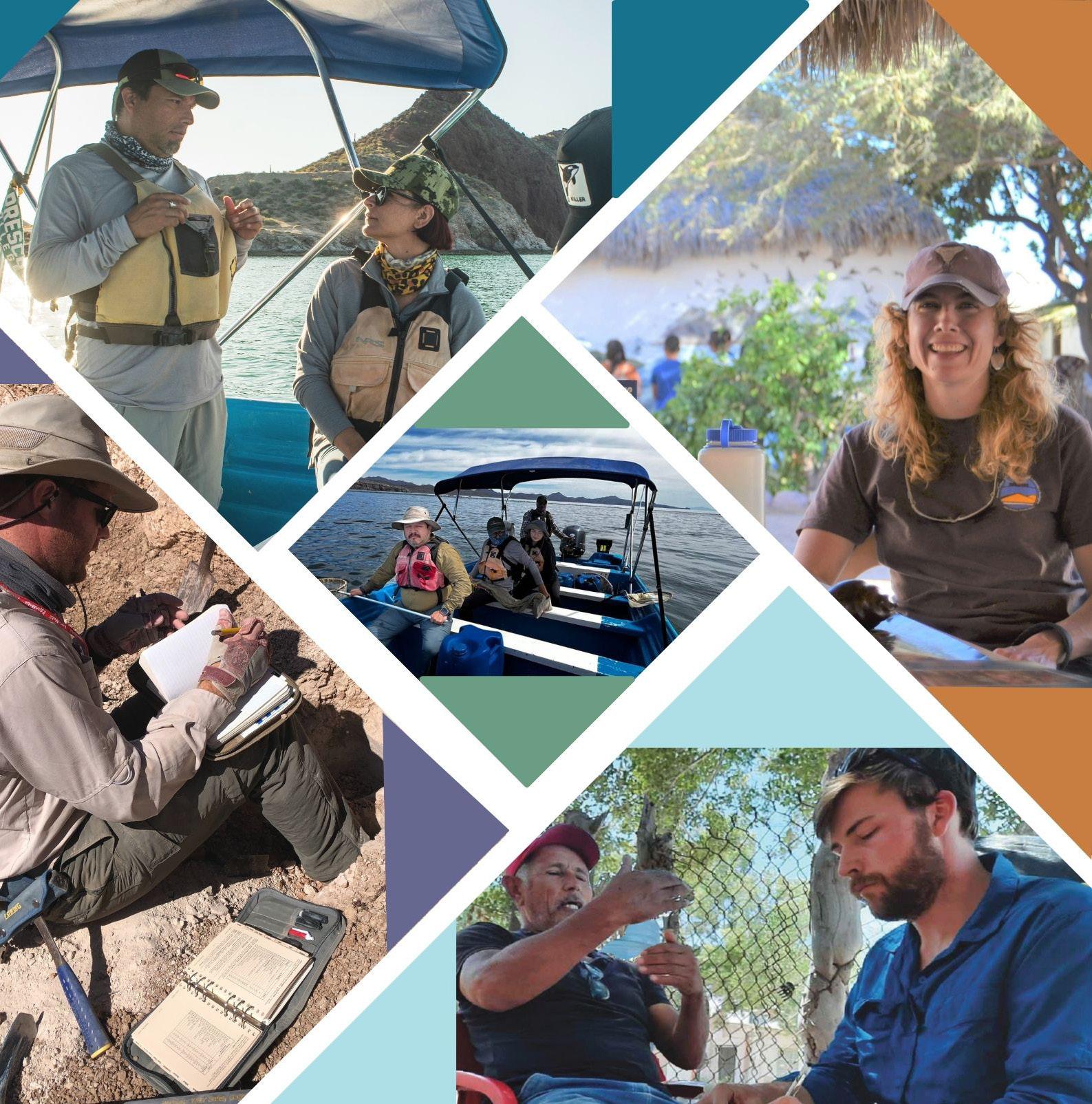
The Center has graciously supported me and my graduate research in Sonora for years. Their unwavering support not only enables my work, but has made it among the most memorable experiences of my life.
Brendan Fenerty Ph.D Candidate
My work has been supported by having a safe, comfortable and stimulating place to call my home base when working with folks in Punta Chueca. During my stays, I am constantly inspired by the enthusiasm and curiosity of the students and staff.
Ph.D Carolyn O’Meara
The Kino Bay Center has provided critical support for my dissertation research by providing introductions to key members of Kino’s conservation community, sharing critical historical documents, and simply providing me with a space of community, home, and care.
Skylar Benedict Ph.D Candidate
Community art is a powerful tool for conservation. Creative images and messages can connect us with nature and provoke thought, feeling and action. This year the Center supported students and community groups in arts projects including theater, muralism, drawing and photography.
Environmental theater in
Elisa Bocanegra is a Prescott College PhD student, Puerto Rican actress and the founder of Hero Theatre, a social and environmental justice theatre company. She collaborated with the Center and Kino community members to create an original play named NUESTRO PLANETA MÉXICO, BAHÍA DE KINO. The play was staged in Kino on October 30th. Community members immersed themselves in every aspect of the production from costume design to script development and acting.


“Creating a play with the residents of Kino Bay was one of the highlights of my artistic career. The community members make environmental activism a part of their daily practice, grandmas and children alike. Prescott’s Kino Bay Center immerses itself in its community. They provide education and support to the people of Kino Bay. I'm honored to have been a part of it both as an artist and a Prescott College PhD student.”
Elisa Bocanegra




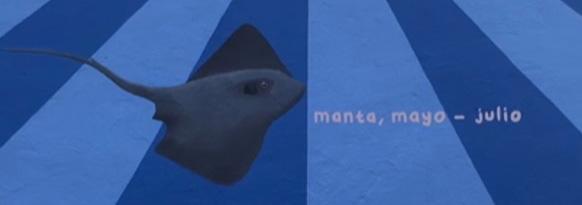
This year the Waterbird Monitoring Program facilitated the third annual Waterbird Art Contest in local communities.
Maria Renée Johnson, a Prescott College graduate who blends art and science for conservation, worked with community leaders to create the mural depicting closed fishing seasons for eight marine species commonly caught and consumed in the region. Rays of sunlight create a twelve-month calendar displaying the seasonal closures for each species. We hope this collaborative mural project inspires stewardship of the marine ecosystem for many future generations.

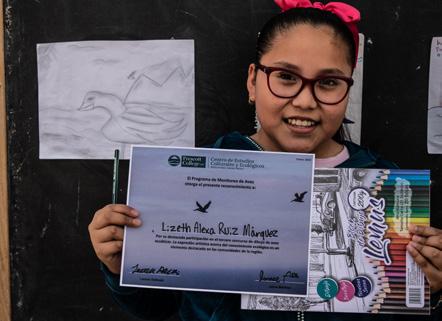
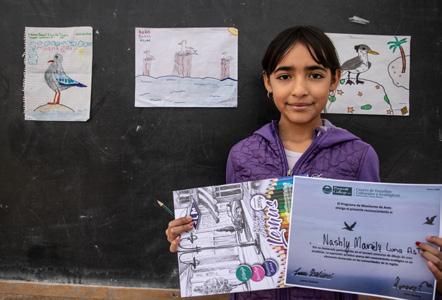
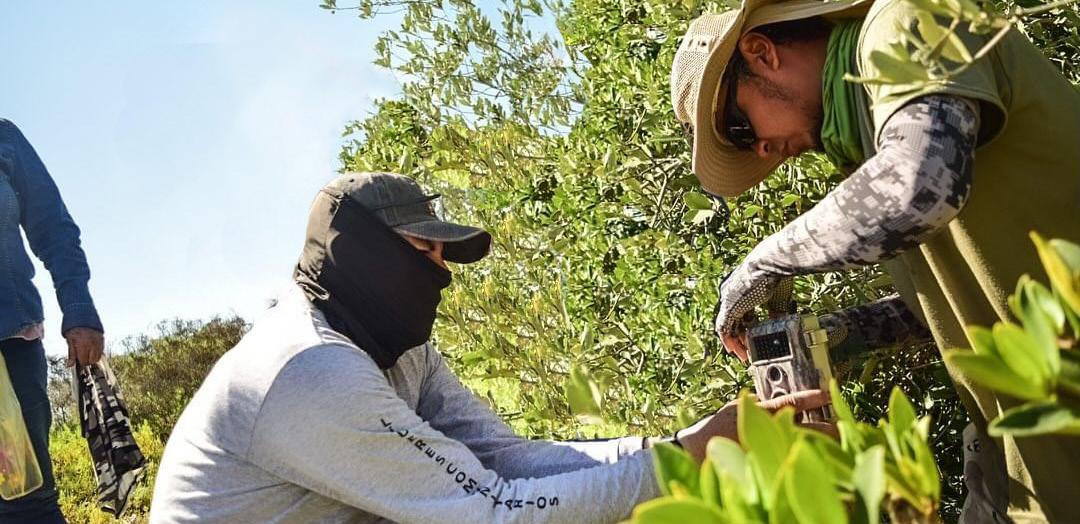
Key Achievements
• Updated information sheet for the Canal del Infiernillo Ramsar Site completed in collaboration with CONANP
• 6 workshops with 72 community members to identify management priorities for the Canal del Infiernillo Ramsar Site
• 11 community projects toward adaptive management objectives in the Laguna La Cruz
Community leadership and effective inter-institutional partnerships are important among the many efforts, agreements, and commitments contributing to sustainable management and conservation of wetlands in the region.
This season the Center continued its active collaboration with community members and other stakeholders toward integrated conservation of Laguna La Cruz and Canal del Infiernillo Ramsar Site wetlands and other coastal ecosystems in the region. Community environmental groups are continually increasing leadership capacity; acquiring the tools and knowledge to participate in conservation and sustainable management of coastal ecosystems. This season the Center accompanied and facilitated processes with local stakeholders to co-create innovative strategies to address complex problems. The Center continued its work to integrate this community work within the context of coastal conservation regionally.

Community leadership and participation are fundamental to achieving biocultural conservation. The Kino Bay Center was founded over 30 years ago on friendships and trust with community members. Recently we have focused more of our time and resources on supporting and accompanying collaborative projects with community members. We define a community project as a collaboration between the Center and community groups toward a common biocultural conservation goal. The objective is to provide training and economic support for community members to be leaders and have livelihoods in connection with conservation. The Center funds projects in education, restoration, monitoring and conservation.
In the 2023-2024 season the Center supported 13 projects involving more than 150 community members.
In its fourth year, the Community Environmental Leaders Group strengthened its role in responding to conservation problems and identifying and initiating solutions-based actions.
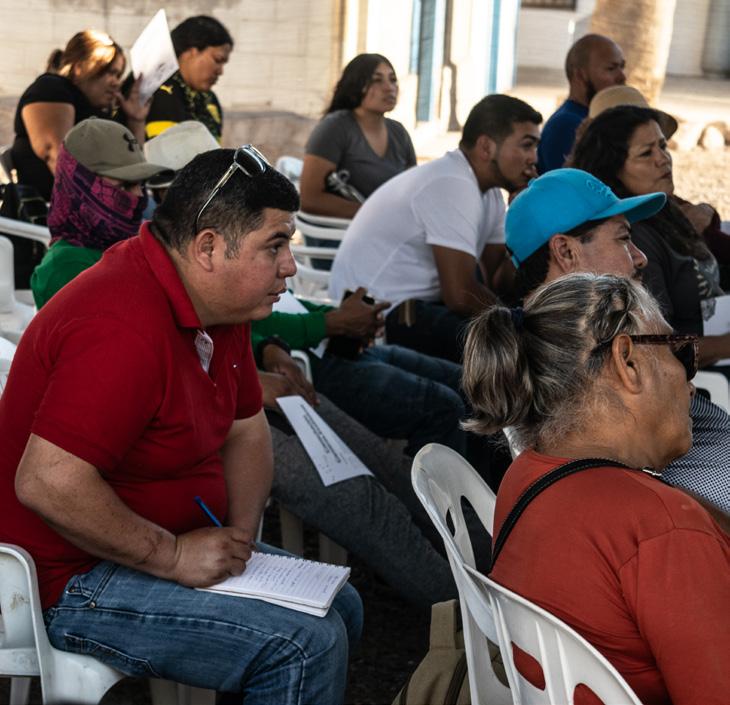


18 capacity building workshops facilitated for ~200 community members on topics related to:
• Technical training for marine mammal, waterbird and sea turtle monitoring
• Wildlife education for tourist providers
• Teambuilding, visioning and work planning for community groups
• Conservation prioritization planning for the Canal del Infiernillo
• Migratory shorebird critical habitat protectio
• Camera trap training for wildlife monitoring
• Mangrove restoration training

Community projects run at different levels of autonomy. Initially, Center staff take more of a leadership role and community members engage as participants. As community members gain more experience and initiative, they assume more leadership responsibility, with Center staff offering continuing support.
Goal: Establish a series of monthly cleanups, as well as raising awarness with tourists and users of the beach and wetlands

34 participants
Results: 10 beach cleanups in Kino and Punta Chueca collecting more than 4 tons of trash from the beach and estuaries
Water quality of Laguna La Cruz
10 participants Goal: Promote the conservation of Laguna La Cruz Ramsar Site, and evaluate its water quality
Results: 9 monthly water sampling surveys of 6 strategic sites in Laguna La Cruz
Grupo Tortuguero of Kino Bay


Goal: Protect sea turtles and their habitat through monitoring and education
Goal: Create of a strategy to resolve local conflicts and promote conservation actions and projects
Goal: Protect Laguna La Cruz and its species, raise awareness among its users and people in general of the importance of wetlands
15 participants
Results: 12 monitoring surveys with 40 new sea turtles registered, regular training and information sharing
Community Leaders of Bahia de Kino
13 participants
Results: 12 group meetings, 2 videos promoting the community projects work, 1 mural about no fishing dates.
Padrés United: Wetland cleanup project
12 participants


Results: 24 subtidal and coastal cleanups along Laguna La Cruz, collecting a total of 8,634 kg of garbage.

Goal: Document sea turtles in feeding areas in the Canal del Infiernillo region by Comcaac community
Goal: Contribute to the protection, rescue and transmission of biocultural patrimony in the Comcaac community
Goal: Promote environmental education in all schools in Bahía de Kino, using the tools of the Environmental Education program as a reference
Goal: To Introduce preschool children to environmental education
Goal: Document distribution, behavior, and biolcultural importance of Bottlenose Dolphins
Goal: Build capacity for waterbird monitoring and conservation by integrating scientific and traditional knowledge
Goal: Build capacity for waterbird monitoring and conservation with Kino Bay youth
Grupo Tortuguero of Punta Chueca
13 participants
Results: 8 monitoring surveys, 27 registered turtles, participation in the national Grupo Tortuguero forum, and in 3 skills and leadership workshops
Biocultural Field School
34 participants

Results: 6 classes of the biocultural field school with a total of 30 children and young people from the community
Eco-Educadoras de la Bahia
9 participants
Results: 5 days of activities teaching 5 different topics, contributing to the knowledge of 57 students between the ages of 9 and 10 years old
Escuelita del Mar
5 participants


Results: 18 days of activities and 8 differetn topics, contributing to the knowledge of 65 students between the ages of 3 and 6 years old
Dolphin Monitoring in the Canal del Infiernillo
3 participants
Results: 2 monitoring surveys in the Canal del Infiernillo, and 1 introductory workshop with 8 participants to recrute new members
Coijaac Bird Monitoring Group
10 participants
Results: 3 bird monitoring surveys to recrute new group members that included field equipment training
Pihuihui Bird Monitoring Group
9 participants
Results: Training and participation of new members toward inspiring interest in future participation




Goal: Familiarize local kids with the waterbird species and connect artistic expression with the appreciation of nature
Waterbird Drawing Contest
Waterbird Drawing Contest
16 participants
Results: 16 drawings received from Kino Bay, Punta Chueca and Desemboque


Key Achievements
• Implementation of our first kindergarten and 5th grade curriculum in collaboration with the community groups
• Accompaniment and development of four community projects with >50 participants
• Community participation in an environmental theater production and a video portraying the local community conservation movement
Community-based and studentcentered environmental education contributes to the development of youth with a profound sense of place and the capacity to be agents of change in their communities.
This season the Environmental Education Program (EEP) strengthened support for community groups as community members built capacity to proactively develop classes, projects and events focused on conservation. Experiential and student-centered ecology classes given in the Bahia de Kino kindergarten and in both primary schools instilled a deep sense of place. The Biocultural Fieldschool continued facilitating experiences that link Comcaac mentors with young people to further the transmission of traditional knowledge.

• 2nd Earth Day Festival organized in collaboration with the community conservation groups and presented on the downtown pier
• 7th Annual World Wetland Day Celebration with a Community Project Exposition and Celebration and a clean-up of Laguna la Cruz, both involving over 150 participants
• Thematic participation in the Day of the Revolution Parade to promote legal fishing
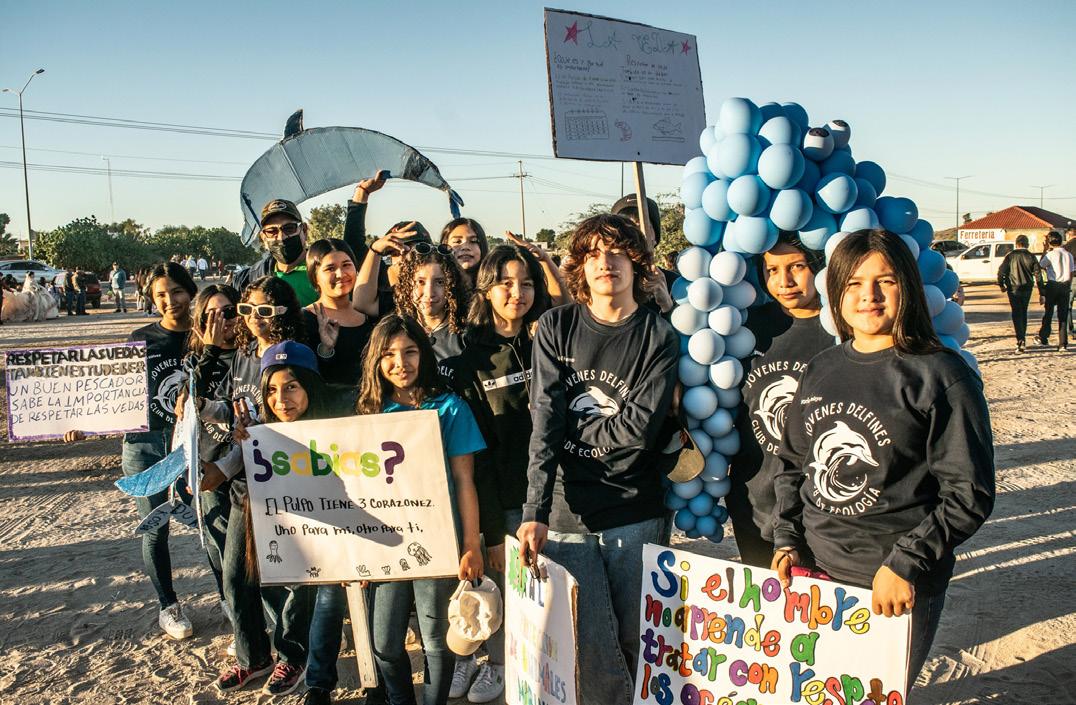

• 46 experiential class sessions with 58 4th and 6th graders in the Nissan primary school
• Demonstration of learning presented by 4th and 6th graders through creative projects including poems, models, posters and presentations
• 14 kindergarten classes and 16 5th grade classes delivered by community members
• Facilitation of shared experiences and collaborations between community conservation groups supported by the Center
• Strengthening of collaborations between different community conservation groups supported by the Center through shared experiences and initiatives
• Increased capacity and initiative of the Community Environmental Leaders Group
Environmental Education activitites were done in many events like parades, Earth Day, Wetlands day, etc.


• Participation of 11 Comcaac community members in regional professional gatherings Key Achievements
• 27 sea turtles recorded during 8 monitoring outings conducted by Grupo Tortuguero of Punta Chueca in the Canal del Infiernillo
• Facilitation of 6 workshops with 72 community members to identify management priorities for the Canal del Infiernillo Ramsar Site
Dialog and consistent collaboration with community members, researchers, students and institutions builds trust, develops leadership capacity and motivates increasing participation in equitable biocultural conservation initiatives.
The Indigenous Community Partnership Program facilitates equitable relationships between the Center, external researchers, educational groups and members of the Comcaac community. The program strives to promote biocultural conservation and territorial defense through community-based initiatives combining Comcaac and western knowledge and approaches. This season we supported community groups in the development of technical, collaborative and leadership capacity. At the same time, we promoted community dialog about environmental concerns and potential biocultural conservation strategies within Comcaac territory. These dialogs motivated increased collaborations between the Comcaac community and the Center and brought to light new ideas for next season.

• Participation of 5 members Comcaac youth, artisans and 10 Prescott College Cultural Geography students in a 4-day biocultural history exploration and camping excursion to Tiburon island
• Facilitation of 12 classroom and field activities with 164 students resulting in life-changing learning about the history, cultural and natural history of the Comcaac territory
• Presentation of Punta Chueca Grupo Tortuguero results by 3 community members in the 25th annual gathering of Grupo Tortuguero de las Californias in Mazatlan


• Formation of strong partnerships between environmental community groups from Punta Chueca and Kino Bay in clean-up campaigns and other initiatives
• Promotion of the co-leadership of Grupo Tortuguero of Punta Chueca through capacity building and fully equipping the group to conduct monitoring in sea turtle feeding areas
• Dialog and support for researchers, student groups and conservationists working in Comcaac territory
• Collaboration with CONANP to update the Canal del Infiernillo Ramsar Site Information Sheet
• Interactive workshops to discuss Ramsar Site update results and future conservation intitiatives with 72 artisans, fishers, tourist providers and leaders
The Kino Bay Center and our community partners are being increasingly recognized on local, regional, national, and international levels for our results and approach in science, community-based conservation, and as a field station supporting a wide variety of biocultural conservation and education initiatives. This year, all of our staff, along with community partners participated in over 10 conferences, conservation planning forums and symposia to further scientific understandings and strengthen collaborations. Every year the Center is contributing to conservation initiatives at a deeper level.




• 9 members of the Bahía de Kino and Punta Chueca sea turtle monitoring groups exchanged experiences with other groups of Grupo Tortuguero de las Californias at their 25th annual meeting in Mazatlan.
• The Center is co-leading a study to evaluate the ecological health of the Gulf of California in order to be able to prioritize and influence future conservation actions.
• The WMP participated in two sessions of the Sonoran Joint Venture Science Technical Committee, enriching our team’s understanding of regional migratory patterns and contributing to our own work for others to do the same.
• The Center participated as experts in the management, planning, evaluation and revision processes for two natural protected areas in the region.
• Staff members participated in community conservation experiences from Mexico City to French Polynesia.
A huge highlight this season was our participation in the N-Gen summit in Alamos (April 24-27)! This dynamic “un-conference” brought together Sonoran Desert researchers from the U.S. and Mexico
Our group facilitated a total of 9 sessions and cumulatively participated in 127 sessions
• 30 participants in total
• 15 Kino Bay Center staff members (including 3 from Kino and 1 from PC)
• 9 Comcaac community members
• 7 Kino community members



• Notable increase in whale sightings after a marked decline in previous years Key Achievements
• Consolidation of collaborations with national and international partners
• Expansion of our study site into the area well north of Tiburon and offshore of Puerto Libertad
• Mentorship for university students and capacity building for community members
Long-term monitoring, research collaborations and participation of community members and students contribute valuable information to the ecological understanding and conservation of cetaceans in the region.
Long-term monitoring provides important information to identify trends and expand scientific knowledge of cetacean populations in the region. This year we significantly expanded our study area to the north, which will ultimately increase our understanding of seasonal distribution and habitat use. This year we increased collaborations with interdisciplinary academic partners and continued our efforts to share our results broadly with partners and general audiences. Professional practicum and thesis students mentored by the Marine Mammal Program grew academically, while simultaneously contributing valuable results.

• 1,991 total cetacean sightings registered during 15 years of continuous monitoring
• 143 sightings of 8 cetacean species (3 mysticetes; 4 odontocetes) in 26 outings this season, including the first sighting of 1 spinner dolphin
• 20 acoustic recordings (>62 min) and 54 drone videos (>92 min) of 3 cetacean species
• 31% increase in number of sightings from last season
• Increased understanding of movements, residence and abundance of 5 cetacean species through the continuous updating of our photo-ID catalogs
• Verification of the importance of Kino Bay and the area south of Tiburon island as critical habitat for cetaceans

• Stronger collaboration with 6 academic institutions, including 3 university departments, and 2 specialized marine mammal NGOs
• Participation in 5 National Protected Area advisory science meetings for San Pedro Biosphere reserve
Information Exchange
• 1 book chapter published through an inter-institutional collaboration
• 3 article manuscripts submitted to peer-review journals, with 1 more in progress
• Presentation of marine mammal information in 2 local environmental festivals
Education and Capacity Building
• Co-direction and mentorship of 4 professional practicum and thesis students
• Capacity building for 2 Comcaac youth participating in Bottlenose Dolphin monitoring in the Canal del Infiernillo
• 5 academic presentations, 4 community workshops and 3 table presentations for Center visitors and the public
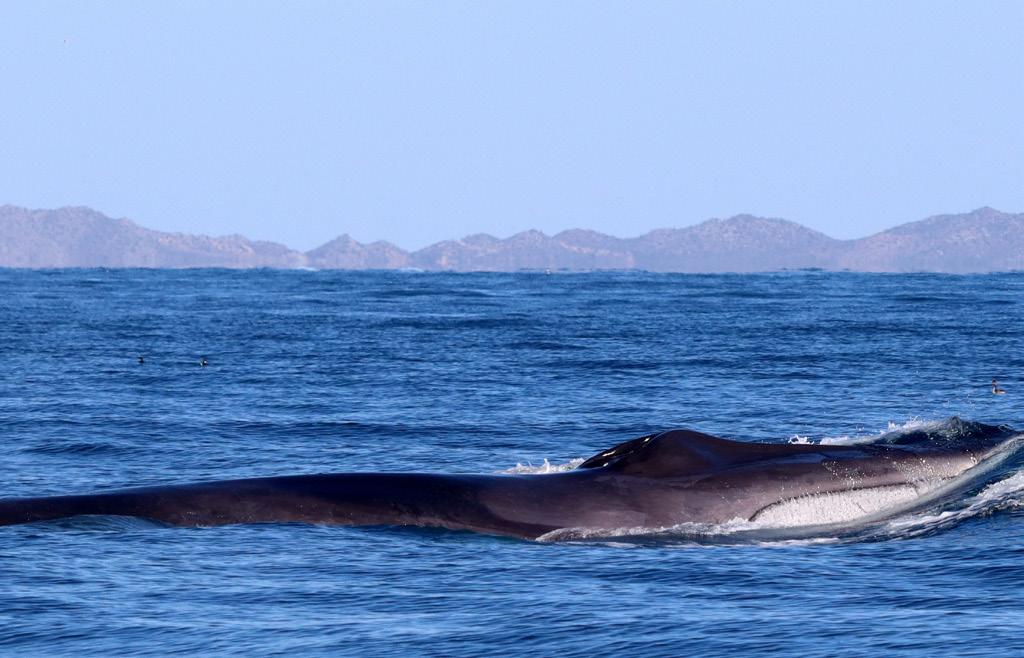

• Submission of peer-reviewed article describing breeding biology of the Craveri’s Murrelets in the region Key Achievements
• Installation of wildlife tracking station in estero La Cruz in collaboration with Motus network
• Completion of critical habitat maps of estero La Cruz and initial dialog with community leaders to develop habitat protection projects Impact
Effective habitat protection and species conservation is rooted in long-term collaborative monitoring that prioritizes community involvement, leadership training, data analysis collaboration and information sharing on the local, regional and international level.
Long-term monitoring projects continued on islands, in regional estuaries, the Canal del Infiernillo, and the open sea. This year continued efforts to publish our exciting findings about rare and endangered Craveri’s Murrelet. Local community members gained hands-on field experience through monitoring projects, workshops and presentations. Art contests were held to further engage youth and raise awareness for species conservation. Collaborations with external researchers, NGOs, governmental agencies, and the general public contributed to coordinated fieldwork with results applied to conservation and management. We look forward to work on banding and tracking projects next season.
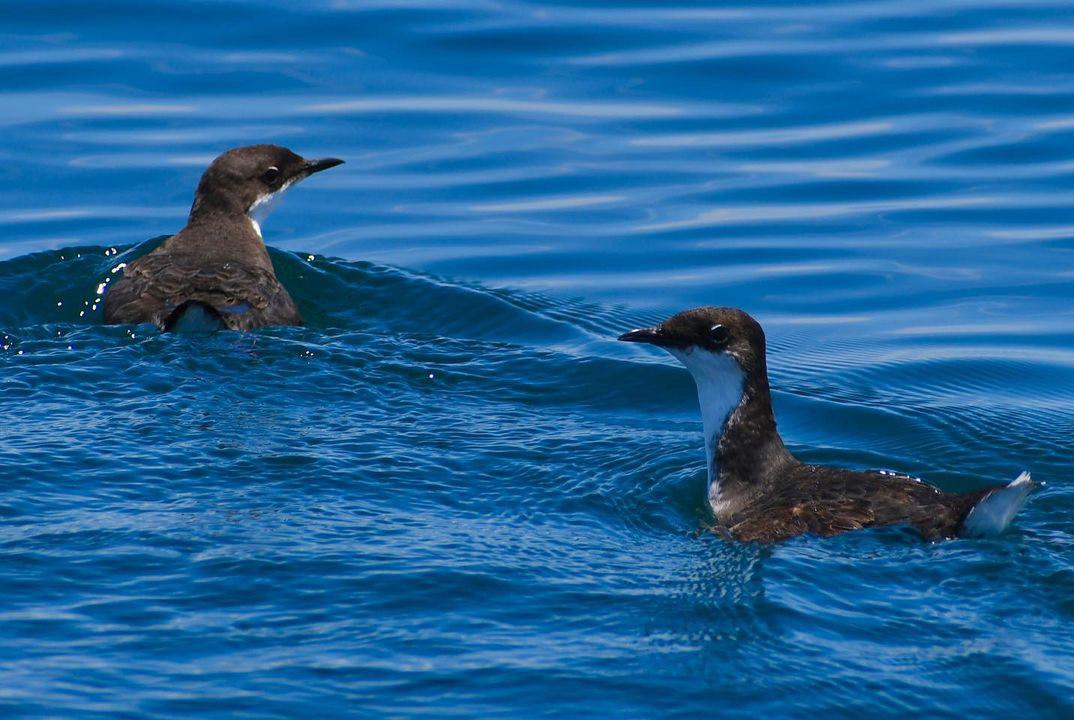
• 52 surveys in estuaries La Cruz, Tastiota, Cardonal, and in the Canal del Infiernillo showing an early arrival but late departure in migratory species
• 53 surveys monitoring 12 nesting species on Alcatraz island showing a late start in the breeding season and high abandonment in the Brown Pelican colony
• Over 3 hours of video footage of Craveri’s Murrelets documenting breeding behavior and 2 hours of audio recordings between adults and chicks
• 10 surveys performed in open ocean, with our expanded northern study site revealing a significant foraging area for seabird species, such as the endangered Craveri’s Murrelets


• Attendance in 4 conferences and forums dedicated to research and conservation
• Presentations in the Sonoran Joint Venture Technical Science Working Group meeting and in the international Pacific Seabird Group Annual meeting
• Participation in collaborative monitoring networks for beach nesting shorebirds, migratory waterfowl, and wintering shorebirds
• Mentorship of 2 Prescott College students and an internship in the program
• 14 community members from youth groups in Punta Chueca and Bahia de Kino participating in monitoring training and 7 field outings
• 2 workshops given to community members to educate about species, habitat protection and conservation


• Consolidation and organization of a long-term database
• Initiation of a formal collaboration between the Kino Bay Grupo Tortuguero and the Center’s newly formed Sea Turtle Monitoring Program
• Participation of 5 Grupo Tortuguero members in professional forums
Long-term and community-based sea turtle monitoring and education efforts build a society in which fishers, youth and women are contributing to the recuperation of the species.
The consolidation of a true partnership between the Kino Bay Center and the Kino Bay Grupo Tortuguero (KBGT) community group moved turtle monitoring in the region to a new level this season. Together, we built capacity in monitoring protocols, teamwork, data management and analysis, reporting, staffing and administration. While monthly monitoring in the feeding areas of Laguna La Cruz and San Pedro Martir continued, data going back to 2010 were organized to be able to analyze trends over time. Community education efforts reached everyone from preschoolers to adult tourist service providers.

• 40 turtles recorded, with 13 recaptures in 12 monitoring outings in Laguna La Cruz
• 22 turtles recorded, with 4 recaptures in 6 monitoring outings at San Pedro Martir island
• Cooperation of fishermen delivering 2 turtles caught as bycatch in nets
• 38.28% increase of average number turtles recorded per outing from the previous season
• 21 stranded turtles recorded representing a 425% increase from last season, possibly due to the strong winds and waves in March, which prevented fishermen from accessing their nets


and community events
• Facilitation of 9 classes and field activities with Center visiting groups to teach about sea turtle ecology, conservation and monitoring techniques
• 2 classes in local primary schools
• Facilitation of activities during the Earth Day and Wetlands Day community celebrations
Capacity building
• Participation 6 workshops focused on strengthening teamwork, ecological knowledge and data collection
• Training in scuba as an additional capture method for monitoring around San Pedro Martir island
• Hiring of 1.5 Center staff members to accompany Grupo Tortuguero’s development


Key Achievements
• Increase of social media reach through more engaging content
• Improvements in design, consistency, content, and visibility of publications
• Specialization of the program towards communication for community conservation
• Production of videos, posters and a magazine to advance conservation efforts in the Canal del Infiernillo
Media and communication connects stakeholders and decision-makers with relevant information, raises awareness, and mobilizes action in ways that strengthen conservation achievements.
Creative and strategic communication played a key role this season in advancing the conservation work of the Center and its partners. Social media, newsletters, press releases, community art, videos and displays raised awareness and motivated action. Students, community members, and staff with an interest in communication were supported in the planning and implementation of communication projects. The Center’s library displays and photo-database were maintained to provide valuable resources for visitors, staff and partners.

• 5 posters, 4 videos and 1 magazine used as tools in 5 participative workshops for constituent groups from Punta Chueca and Desemboque
• Facilitation of a presentation about communication for conservation at the N-Gen summit in Alamos Sonora
• 8 television and radio spots featuring Center staff and partners providing important information about specific conservation issues in the region




• Update and management of the photo database to facilitate retrieval of photos tagged with metadata
• Inventory and maintenance of the Center’s library and display resources
• Organization of quality photos from 8 Prescott College classes, 16 visiting groups and all Center and program activities
Center’s work
• 60% increase in interaction on social media
• 5 engaging and attractive newsletters widely distributed to highlight the variety of work done through the Center
• Distribution of the Center’s first press release to local news media platforms

• Significant funding from the Center’s first two contracts
• Development of a fully-functional operations area on campus
• Overall increased budget from all sources leading to program, staff and facilities improvements
• Active participation of the Center’s Executive Council provided vital leadership in a year of rapid growth
Enhancing the efficiency and effectiveness of the Center as we develop as an institution leads to deeper achievements in community-based environmental conservation.
This season the Kino Bay Center has continued our journey toward refining and professionalizing all aspects of our operation. Additions and upgrades to the physical, personnel, and administrative structures provided improved experiences and outcomes for students, visitors, scientists and local community partners. In addition, the significant increase in the Center’s overall revenue from all sources was well-managed to expand and deepen the Center’s results in education, research, community involvement, and conservation in the region. Next season we will continue the development of the south campus operations center, and focus on organizational systems and aesthetics at the Center.

• Institutional recognition leading to significant increase in funding from the Center’s first two contracts
• Highest budget due to diversification of income sources
• Increased donations from Mexican donors
• 8 grants submitted, 3 accepted, 3 denied, 2 pending
• Two alumni trips raised money for the acquisition of a new panga!
• Record revenue raised from external groups (16 multi-day groups generating ~95% revenue increase over last year)
• The Heidi Koskinen Scholarship for students studying in Kino has awarded $49,500 to 33 students since 2004
• In-kind donations of a boat and a work truck


• Completion of the final year of a $500,000 5-year investment plan including office space, improvement of our panga fleet, addition of a bathroom and the development the south campus as an operations center
• 100% increase in revenue earned from Visiting Groups
• Hiring of 2nd boat captain, administrative assistant and maintenance staff member to better support our work
• Upgrade to new and improved internet connection and improved maintenance of vehicle fleet
• Compliance with all rules enabling the Mexican NGO to maintain its tax-deductible status
• Effective budget management
• Progress toward a complete Operations Manual

Rey Alfonso Morales López Leader of Grupo Tortuguero of Punta Chueca
“Getting involved with the Kino Bay Cener awakened in me a deeper interest in conservation in general. I first started participating in a cleanup projects on Tiburon island, and now I am the leader of Grupo Tortuguero of Punta Chueca, one of the Center’s community projects. Thanks to all the support from the Center, this sea turtle conservation project became possible.”
Benedict, PhD Candidate
“I have collaborated with the Kino Bay Center since 2022. As an anthropology researcher studying community-led coastal conservation, the Center has been a vital place to feel welcomed by the many people who work to care for Bahia de Kino’s precious wetlands. As a Fulbright Garcia-Robles Scholar, the Center helped me
navigate the logistical complexities of long-term research in Mexico and showed me the incredible staying power of a community forging restorative relationships between Sonora’s people and coastal wetlands.”

Luis Landaverde Community Project Leader

“One of the best decisions I’ve made was to start the CREDESPA project, and to reach out and be supported by this prestigious institution, Prescott College.
Working with The Kino Bay Center has shown me a very different way of living, given me many opportunities and taught me many lessons. I feel very fortunate to be part of it all, I hope we continue building ties so that this community grows, develops and produces more environmentalists committed to our planet”.

“I spent the majority of my Prescott College career at the Kino Bay Center. Initially I was drawn by the allure of studying marine sciences and field biology in a beautiful corner of the world, but experiences with the local communities opened my eyes to all that is required to conserve biodiverse environments. Now, as a field assistant and future conservation fellow, I am determined to do my part by using skills that I have gained from my studies to help conserve this magnificent region for generations to come.”

Ann Lawrie Aisa
Ann-Lawrie Sloan Aisa (1930-2023) and Pedro Aisa (1921-2019) were life-long educators, learners, outdoor enthusiasts and advocates for experiential education, social justice and Hispanic rights. Their long and interesting lives of service brought them to Prescott College in 1966, where they were both charter faculty at the “newly formed college that shared their core values of education as a conduit to creating a citizenship capable of transforming society.” Ann-Lawrie was the Dean of Students and Pedro taught Spanish, literature, and philosophy. They shared their love of the Hispanic world making it possible for students to experience it personally. Most memorable were the Prescott College trips to Sonora, Mexico and La Mancha, Spain retracing Don Quijote’s route on horseback. They believed that the study of a language is not an end in itself, but offers a window to understanding another culture and world-view. The Kino Bay Center is grateful to Pedro and Ann-Lawrie for the seeds they planted at Prescott College and for honoring and supporting the work of the Kino Bay Center upon their passing.
Please contact us for more information on how you can include The Kino Bay Center in your estate plans.
Though they’ve were only part of the Center community for a year, Holly and Hale’s contributions and place in our hearts have made a huge impact! As interim Station Managers Holly and Hale took our organizational systems, computer network, group dynamics and vehicle maintenance to another height of professionalism. We will miss the entire family!
Thank you!!!

The Center depends on donations and support from foundations and a wide range of individuals. All of our donors connect with the work of the Center in ways that are special and unique to their lives. It is an inspiring array of connections. Individual donors are an important part of our history, our community and the contributions the Center makes in people's lives.

Every donation makes a difference! THANK YOU to everyone who donated this year - we couldn’t do it without you.
We regularly have "Friends and Family" trips to bring donors together to experience and interact with the Center, students, staff, community members and ecosystems.
$50,000:
Merrilee Caldwell and Marcus Randolph.
$25,000 - $49,000: Annette Tracy and Estate of Ann Lawrie.
$10,000-$24,999: Jeff Bayha, Mark Thorkelson (In-Kind).
$5,000-$9,999:
Toni Kaus and Mary Trevor, Nat and Sara Cobb, David Meeks and the KAKATU Foundation.
$2000-$4,999: Laurence Meltzer, Doug Hulmes, Terry and Cathleen Eckheart, Geoff Barnard, Jerry Secundy.
$1000-$1999:
Trica Oshant Hawkins, Alejandra Esponda, Fletcher Clark, Bruce Muller, Naomi Blinik, Elizabeth Waggoner, Travis Wilkinson, Daniel Secundy, Susan Rudin, Katrina Rogers, Steve Hummer, Joel Hiller, Leanne Hanson, Jennie Duberstein.

$500-$999:
Amy Meltzer, Celia Chapman, Karin Zachow, Abram Fleishman, Debra Viess, Caitlin Reilly, Mary Mundhal-New, Hanna McGowan, Karen McCreary, Kent Madin.
$100-$499:
Dennis Swaney, Taylor Stewart, Alan Weisman, Julia Stewart, Kathleen Murphy, Wayne Van Vorhies, Anne Gibson, Dominic Wells, Brian Chankecka, David Young, Alan Weisman, Michael Sweet, Peter Stewart, Brit Rosso, Mark Riegner, John Isaacs, Richard Gersten, Joanie Clingan, Claudia Bach, Gret Antilla, Sandra Andersen, Emily Affolter, Robert Meltzer, Catherine Hickey, Lisa Floyd-Hanna, Tom Fleischner, Safari Fang, Emily Clark, Tina Barr, Veronica Wolff, Kayla McLeod, Scarlett Kerr, Bridget Hoefel, Marlee Brinson, Joel Barnes, Haley Schreier, Luke Zuehlsdorff, Mónica Maldonado, Laura Exar, Mark Cassidy.

Scan
September 2023 March 2024


From top left to right; Virginia Yáñez Parra, Holly Thomas-Hilburn, Hale Thomas-Hilburn, Ramón Emilio Osuna Zayas, Ramón Ulises Becerra Lamadrid, Julio Paredes Carrasco, Héctor Pérez Puig, Gabriela Noemí Salazar Sánchez, Edgar Elí Magdaleno, Aarón Asahel Barnett Romero, Cosme Damián Becerra, Francisco Jaime Martínez Reyes, and Ulises Jaasiel Rancaño Castillo.
From the bottom left to right: Ellie and Amelia Thomas-Hillburn, Cosme Damián Becerra Esquer, Grisel Heredia Córdova, Maribel Becerra Esquer, Lorayne Meltzer, Frida Yáñez Hernández, Ana Gabriela Martínez Vargas, Johana Nieblas Mejía, Lauren Dolinski, Aly Edwards, Elise Maynard y Luis Moreno González.
• Carlos Castillo
• Gisela Heckel
• Carolyn O’Meara
• Eduardo Palacios
• Dan Anderson
• Lisa Floyd-Hanna
• Jerry Secundy (Chair)
• Geoff Barnard
• Joel Hiller
• Nat Cobb
• Annette Candanedo
• Mark Thorkelson
Photos courtesy of:
Ulises Rancaño, Ana Gabriela Martínez, Héctor Pérez Puig, Gabriela Salazar, Cosme Damián Becerra , Francisco Jaime Martínez, Edgar Magdaleno, Lauren Dolinski and Grupo Tortuguero de Bahía de Kino.


